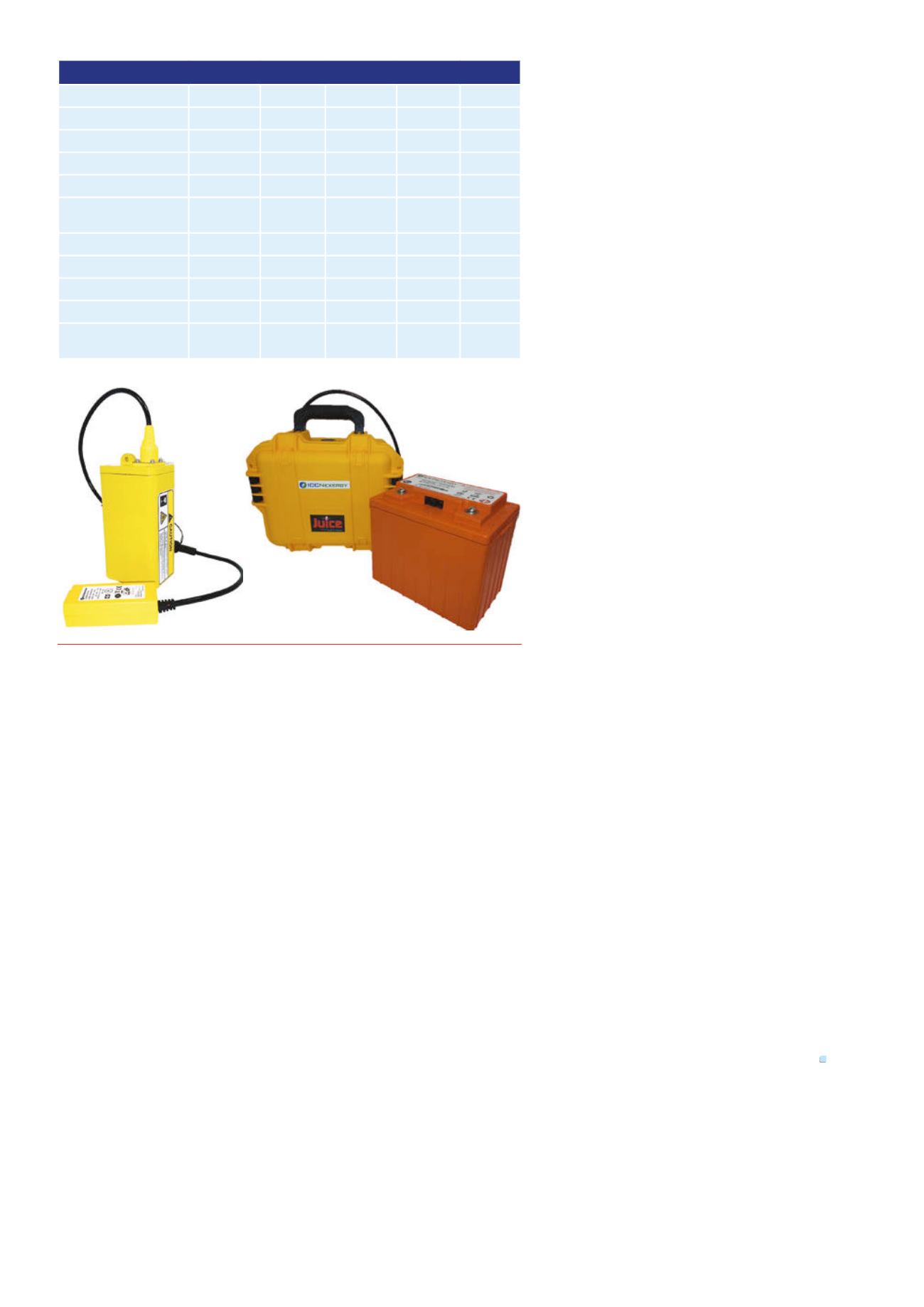
18 |
Oilfield Technology
August
2015
yields an energy density that is 1.5 to 5 times higher than the other
chemistries for a given volume. This is highly desirable when size and
weight matter and long run time is also required. As a comparison,
the chemistry chart (Figure 4) shows SLA on the bottom left with a
volumetric energy density value of approximately 125 Wh/l and a
gravimetric energy density of approximately 50 Wh/kg, (maximum
values). Today’s Li-ion chemistries provide approximately 700 Wh/l,
5.6 times that of SLA and approximately 250 Wh/kg, five times that of
SLA respectively, (maximum values).
Lithium iron phosphate technology (LFP), a variant of lithium-ion,
while not as high as conventional Li-ion provides an increase over SLA
at approximately 350 Wh/l and 120 Wh/kg. LFP may not yield as much
energy but has other characteristics that are very positive in relation
to life and performance.
Lithium-ion chemistry develops voltages in the range of 3.3 V to
3.7 V per cell, in comparison to 2.0 V per cell for a lead acid chemistry
and 1.2 V per cell for both nickel cadmium and nickel metal hydride.
The higher voltage and the higher energy density enables higher
voltage assemblies with fewer individual cells, which helps keep size
and weight down.
A side by side comparison of features and benefits of the various
chemistries can be seen in Table 1; Li-ion chemistry is not only higher
in energy density but also offers:
Ì
Ì
Much longer product life (cycle life).
Ì
Ì
Greater capacity at end of life (80% versus 60% SLA).
Ì
Ì
Faster recharge time for improved productivity.
Ì
Ì
Excellent storage capacity retention and recovery.
Ì
Ì
Wide temperature range for extreme temperature
environments.
Lithiumbatteries inuse
It is hard to argue with the many benefits of lithium-ion
and, as a result, many exploration contractors have moved
to or added large lithium-ion batteries to replace the lead
acid batteries in their inventory. Larger Li-ion batteries
are available in capacities ranging from 20 Ah to 50 Ah and
in some cases can be joined in a parallel configuration to
provide up to 100 Ah capacity that can be used as direct
replacements to commonly used lead acid batteries. Some
offerings are specifically created for the seismic market
designed with fully sealed thick plastic cases, specialised
connectors and built to interface directly with OEM seismic
devices, while others look a lot like a standard SLA battery
that can be housed in a waterproof case for use outdoors
(Figure 5).
Li-ion packs are also designed into smaller assemblies
and are found paired with or built into the seismic
recording device. Today, Li-ion batteries are used as the
main power source for all wireless land seismic acquisition
systems.
Offshore seismic exploration equipment, such
as towed and seabed equipment, utilise a variety of
chemistries for portable power. Some of the chemistries
used are SLA, alkaline, nickel metal hydride, lithium
primary and Li-ion. Devices that are tethered and towed,
some resembling torpedoes, have external or internal
batteries depending on the device. In some cases, the
devices are powered by SLA batteries mounted onboard a
ship that provides power through a tethered connection to
the device. Other towed devices have internal batteries to
provide power; these internally powered devices typically
utilise nickel metal hydride or Li-ion batteries. Since size and weight
are less critical to offshore devices than land seismic equipment, not
all devices have converted to Li-ion technology, as is the case with
land use equipment.
Large seabed devices are often deployed for months at a time
and therefore, do not have the luxury of recharging. Due to the nature
of use, non-rechargeable primary cells are typically used in these
applications and adapting to rechargeable Li-ion technology is not
likely to occur.
Wireless nodes are an early adopter of Li-ion technology to reduce
size, weight and to provide long run time. Wired nodes are likely to
remain the choice in open areas, such as deserts, where cable can be
quickly laid using a vehicle, and where drifting sand can swallow up
wireless units and the valuable data they hold. The adoption of large
Li-ion batteries to power the cabled systems is growing.
The evolution of seismic data-gathering techniques will continue
to require battery power as its main source of energy, and Li-ion
technology will continue to be the best choice as it continues to
evolve in its energy density and performance characteristics.
References
1.
Crice, D., ‘Seismic Surveys Without Cables’, GEO Expro, (2011).
2.
Durham, L. S. ‘A Wireless Future? Cables Can Tangle Seismic Plans’,
AAPG Exployer, (2007).
3.
‘ge0physicsrocks’ 3D Seismic. Retrieved from
/
watch?v=hxJa7EvYoFI, (August 29, 2011).
4.
Marine Seismic Methods. (2011, December 11). Retrieved from
:
/
Table 1. Chemistry comparison.
Lead acid Ni-Cd
Ni-MH
Li-ion
LiFe
Cell voltage
2 V
1.2 V
1.2 V
3.6 - 3.7 V 3.2 - 3.3 V
Energy density (Wh/Kg)
50
70
110
250
120
Cycle life
250
500 - 1000 500 - 1000 500 - 1000 >2000
End of life capacity
60%
80%
80%
80% 80%
Capacity rating
method
C/20
C/5
C/5
C/5
C/5
Charging time
6+ hrs
1+ hrs
1.5+ hrs
2+ hrs
1+ hrs
Weight
5X
3.5X
2.3X
1X
2X
Size
5X
4X
1.75X
1X
2X
High temp survivability
1X
2X
1.5X
2X
2X
Long term storage
recovery
1X
1.5X
1.5X
2X
2X
Figure 5.
(Left) SS18 12V 18Ah seismic battery. (Right) U1LiFe batterywthwaterproof
juice case.


